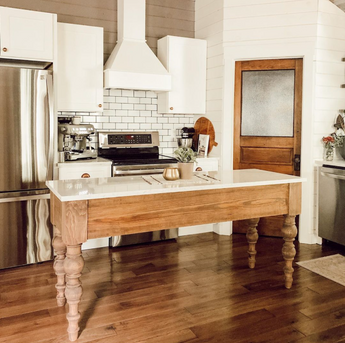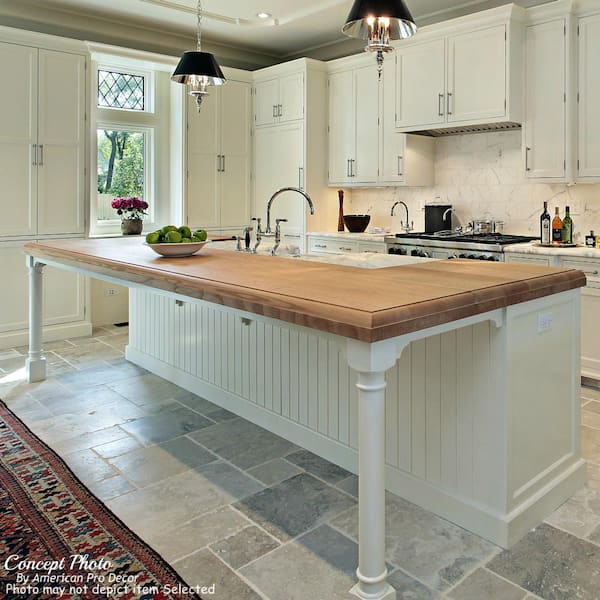Just how to Include a Kitchen Island Leg into Your Kitchen Remodel
Wiki Article
Discovering the Necessary Functions of a Kitchen Island Leg for Your Culinary Area
The cooking area island serves as a central center in any culinary space, and the choice of leg layout is critical in boosting both its capability and aesthetic charm. Understanding the vital features of cooking area island legs-- including material options, style styles, and stability factors-- can substantially affect the total experience within the cooking area.Significance of Kitchen Area Island Legs
Kitchen area island legs play a critical role in both the functionality and appearances of a kitchen space. They not just sustain the weight of the island but additionally boost the total style, adding to the kitchen area's aesthetic charm. The choice of legs can determine the design of the cooking area, be it modern, conventional, or rustic.Functionally, robust and properly created legs guarantee stability, permitting the risk-free usage of the island for various tasks such as food prep work, dining, or entertaining. Strong legs stop wobbling and moving, offering a trustworthy surface area for day-to-day activities.
In addition, the height and placement of the legs can influence the convenience degree for those seated at the island. A well-considered elevation can fit bar stools or chairs, promoting a welcoming environment for celebrations.
In enhancement to these sensible factors to consider, kitchen island legs can function as a centerpiece in the room (kitchen island leg). Decorative or distinctively designed legs can boost the layout aesthetic, making the island a centerpiece. Hence, selecting the best cooking area island legs is essential for balancing kind and feature in any type of culinary area
Product Options for Legs
Selecting the proper material for cooking area island legs considerably affects both longevity and design. Common product choices include steel, rock, and timber, each offering distinctive advantages.Timber is a prominent option because of its heat and convenience. It can be easily tailored to match various design designs, from rustic to contemporary. Hardwoods like oak and maple supply excellent stamina and long life, while softer woods can be a lot more vulnerable to damage.
Metal legs are favored for their streamlined, modern visual. kitchen island leg. Stainless steel and light weight aluminum are not just durable but likewise resistant to rust and rust, making them excellent for kitchen area atmospheres. They can develop a commercial look and are usually readily available in different surfaces to enhance other kitchen area elements
Stone legs, such as granite or marble, include an element of high-end and stability. While heavier than other materials, they use exceptional resilience and can hold up against substantial weight. Nevertheless, they may call for added support to make sure appropriate equilibrium.
Inevitably, the selection of material need to straighten with both practical demands and the general layout vision of the kitchen area room, guaranteeing that the island legs enhance both utility and visual appeals.
Layout Designs to Consider
What style styles should be taken into consideration when picking legs for a kitchen island? The selection of leg style substantially affects the general visual of your culinary area. For a modern cooking area, smooth and minimalistic leg styles, such as stainless steel or geometric shapes, can enhance the modern-day charm, giving a tidy and clean look.In comparison, typical cooking areas gain from classic designs such as transformed or carved wooden legs, which add heat and personality. These choices typically include intricate details that enhance classic furnishings. For a rustic setting, consider legs made from recovered wood or functioned iron, which bring an organic, earthy top quality to the space.
If you lean in the direction of an industrial style, robust steel legs with a distressed coating may be ideal, providing an edgy yet innovative touch. Furthermore, farmhouse design kitchens can incorporate beefy legs that evoke a sense news of sturdiness and homeliness.

Height and Security Variables
The elevation and stability of a kitchen area island are vital elements that straight affect its functionality and user experience. An excellent kitchen island leg must offer sufficient elevation to accommodate a selection of tasks, from cooking to laid-back dining. Normally, kitchen area islands stand between 36 to 42 inches high, straightening with conventional counter and bar heights. This range makes sure convenience for users while performing different tasks, therefore improving the overall functionality of the area.Security is equally crucial, especially as cooking area islands often function as prime focus in cooking environments. A secure leg style decreases wobbling and changing, which can bring about mishaps or pain during use. Products such as solid wood, steel, or a combination thereof are commonly employed to achieve the essential sturdiness. The leg's add-on to the island's base must be secure, making certain longevity and resilience against the wear and tear of everyday use.
Modification and Devices
Customization alternatives and accessories for kitchen area island legs can considerably boost both the visual charm and capability of the room. Property owners can pick from a variety of materials, consisting of wood, rock, and steel, permitting smooth assimilation with existing kitchen design. The option of surface-- be it a natural discolor, paint, or powder layer-- more individualizes the look, guaranteeing that the island matches the overall layout motif.In addition to product and coating, house owners may additionally discover the incorporation of accessories such as ornamental brackets, adjustable feet, or incorporated shelving. Brackets can use added assistance while adding to a rustic or modern visual. Flexible feet are specifically beneficial for uneven flooring, ensuring the island stays stable and level, which is important for both safety and use.

Conclusion
In final thought, cooking area island legs serve a vital role in supplying security and enhancing the general visual of the cooking area. The selection of materials and style styles adds to both performance and aesthetic charm, while considerations of height and security make certain practical use. In addition, modification choices and devices can elevate the kitchen island, making it an unique centerpiece within the home. Hence, cautious consideration of these functions is necessary for an effective kitchen style.The kitchen island serves as a main center in any type of culinary space, and the option of leg style is essential in boosting both its functionality and aesthetic allure. Comprehending the essential functions of kitchen area island legs-- consisting of product options, style styles, and security elements-- can considerably impact the total experience within the kitchen.Kitchen area island legs play a critical role in both the functionality and aesthetics of a kitchen room.What style styles should be considered when picking legs for a kitchen area island?In final thought, kitchen island legs serve an important duty in offering security and improving the overall visual of the culinary area.
Report this wiki page